What is Shortcuts
Shortcuts is supposed to be a program that will give easy access to Amazon, CNN, Facebook, Netflix, etc, but according to security specialists, this program acts as Adware. Adware is considered by many to be synonymous with ‘malware’. It is a malicious program which shows unwanted ads to computer users. Some examples include pop up advertisements, various offers and deals or unclosable windows. The Shortcuts adware can change web browser settings, redirect internet browsers to scam webpages, display intrusive ads from various third-party ad networks and these unwanted advertisements is hard to close.
In most cases, Shortcuts installs on the computer in a bundle with freeware that users downloaded and installed from the InterNet.

Unwanted ads
Another reason why you need to uninstall Shortcuts is its online data-tracking activity. It can monetize its functionality by collecting user data from your surfing sessions. This privacy info, subsequently, can be easily sold to third party companies. This puts your user info at a security risk.
Therefore, Shortcuts does not really have beneficial features. So, we suggest you uninstall it sooner. This will also prevent the adware software from tracking your online activities. A full Shortcuts removal can be easily carried out using manual or automatic solution listed below.
How does Shortcuts get on your PC
The adware was probably installed on your computer when you installed certain free programs such as Email checker, PDF creator, video codec, etc. Because more often than not, adware can be bundled with the installation files of Softonic, Cnet, Soft32, Brothersoft or other similar software download websites.
Thus, you must be very careful when running any files downloaded from the World Wide Web! Always read the User Agreement, Software License and Terms of Use carefully. In the installation wizard, you should select the Advanced, Custom or Manual installation option to specify which components and additional apps to install, otherwise you risk infecting your personal computer with adware or a potentially unwanted application (PUA).
Threat Summary
| Name | Shortcuts |
| Type | adware, potentially unwanted program (PUP), pop up advertisements, popups, pop-up virus |
| Symptoms |
|
| Removal | Shortcuts removal guide |
How to remove Shortcuts adware from Chrome, Firefox, IE, Edge
We can assist you remove Shortcuts from your web-browsers, without the need to take your device to a professional. Simply follow the removal instructions below if you currently have the intrusive adware software on your device and want to remove it. If you’ve any difficulty while trying to delete the Shortcuts adware, feel free to ask for our help in the comment section below. Read it once, after doing so, please bookmark this page (or open it on your smartphone) as you may need to exit your web-browser or restart your PC.
To remove Shortcuts, perform the following steps:
Manual Shortcuts removal
This part of the post is a step-by-step instructions that will show you how to delete the adware manually. You just need to carefully complete each step. In this case, you do not need to install any additional tools.
Uninstall suspicious applications using MS Windows Control Panel
You can manually delete most nonaggressive adware software by removing the application that it came with or removing the adware itself using ‘Add/Remove programs’ or ‘Uninstall a program’ option in Microsoft Windows Control Panel.
Windows 8, 8.1, 10
First, click Windows button

After the ‘Control Panel’ opens, click the ‘Uninstall a program’ link under Programs category as displayed in the following example.

You will see the ‘Uninstall a program’ panel as shown on the screen below.

Very carefully look around the entire list of programs installed on your PC system. Most likely, one of them is the Shortcuts adware. If you’ve many applications installed, you can help simplify the search of malicious applications by sort the list by date of installation. Once you have found a suspicious, unwanted or unused application, right click to it, after that click ‘Uninstall’.
Windows XP, Vista, 7
First, click ‘Start’ button and select ‘Control Panel’ at right panel as displayed on the image below.

When the Windows ‘Control Panel’ opens, you need to press ‘Uninstall a program’ under ‘Programs’ as on the image below.

You will see a list of applications installed on your PC. We recommend to sort the list by date of installation to quickly find the apps that were installed last. Most likely, it’s the Shortcuts adware. If you are in doubt, you can always check the program by doing a search for her name in Google, Yahoo or Bing. After the program which you need to delete is found, simply click on its name, and then click ‘Uninstall’ like the one below.

Remove Shortcuts adware software from Internet Explorer
If you find that IE web browser settings like default search provider, newtab and startpage had been changed by Shortcuts , then you may return your settings, via the reset web-browser procedure.
First, open the Internet Explorer. Next, click the button in the form of gear (![]() ). It will display the Tools drop-down menu, click the “Internet Options” like below.
). It will display the Tools drop-down menu, click the “Internet Options” like below.

In the “Internet Options” window click on the Advanced tab, then click the Reset button. The Internet Explorer will open the “Reset Internet Explorer settings” window as shown on the image below. Select the “Delete personal settings” check box, then click “Reset” button.

You will now need to restart your personal computer for the changes to take effect.
Remove Shortcuts from Google Chrome
If you have adware, Shortcuts removal problems or Google Chrome is running slow, then reset Google Chrome can help you. In this guidance we’ll show you the way to reset your Google Chrome settings and data to original state without reinstall.

- First, start the Google Chrome and click the Menu icon (icon in the form of three dots).
- It will display the Google Chrome main menu. Choose More Tools, then click Extensions.
- You’ll see the list of installed extensions. If the list has the addon labeled with “Installed by enterprise policy” or “Installed by your administrator”, then complete the following guidance: Remove Chrome extensions installed by enterprise policy.
- Now open the Google Chrome menu once again, click the “Settings” menu.
- Next, click “Advanced” link, that located at the bottom of the Settings page.
- On the bottom of the “Advanced settings” page, click the “Reset settings to their original defaults” button.
- The Chrome will open the reset settings prompt as on the image above.
- Confirm the browser’s reset by clicking on the “Reset” button.
- To learn more, read the article How to reset Google Chrome settings to default.
Remove Shortcuts adware from Mozilla Firefox
If Mozilla Firefox settings are hijacked by the adware software, your internet browser shows annoying popup ads, then ‘Reset Mozilla Firefox’ could solve these problems. Essential information such as bookmarks, browsing history, passwords, cookies, auto-fill data and personal dictionaries will not be removed.
Launch the Mozilla Firefox and press the menu button (it looks like three stacked lines) at the top right of the web-browser screen. Next, click the question-mark icon at the bottom of the drop-down menu. It will show the slide-out menu.
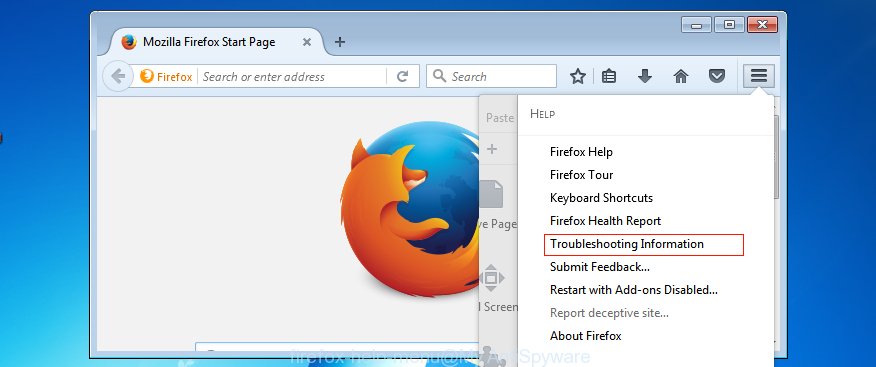
Select the “Troubleshooting information”. If you are unable to access the Help menu, then type “about:support” in your address bar and press Enter. It bring up the “Troubleshooting Information” page as displayed in the figure below.
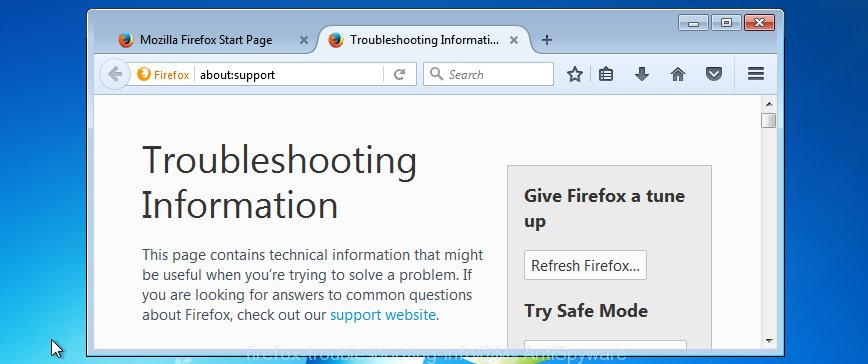
Click the “Refresh Firefox” button at the top right of the Troubleshooting Information page. Select “Refresh Firefox” in the confirmation dialog box. The Firefox will begin a process to fix your problems that caused by the Shortcuts adware. When, it’s finished, press the “Finish” button.
Automatic Removal of Shortcuts adware
Manual removal instructions may not be for everyone. Each Shortcuts removal step above, such as deleting dubious applications, restoring affected settings, removing the adware software from system settings, must be performed very carefully. If you are in doubt during any of the steps listed in the manual removal above, then we recommend that you follow the automatic Shortcuts removal guide listed below.
How to get rid of Shortcuts adware with Zemana AntiMalware
Zemana AntiMalware (ZAM) is one of the best in its class, it can search for and remove a large number of of various security threats, including adware, hijackers, spyware and trojans that masqueraded as legitimate computer programs. Also Zemana Free includes another tool called FRST – is a helpful program for manual removal of files and parts of the Windows registry created by malware.
Zemana can be downloaded from the following link. Save it on your Windows desktop or in any other place.
164814 downloads
Author: Zemana Ltd
Category: Security tools
Update: July 16, 2019
After downloading is complete, launch it and follow the prompts. Once installed, the Zemana Free will try to update itself and when this process is complete, press the “Scan” button to perform a system scan with this tool for the Shortcuts adware.

Make sure to check mark the items which are unsafe and then click “Next” button.

The Zemana AntiMalware will remove Shortcuts adware software and move the selected items to the program’s quarantine.
Get rid of Shortcuts from internet browsers with HitmanPro
HitmanPro is a portable program which requires no hard setup to find and remove Shortcuts adware. The program itself is small in size (only a few Mb). Hitman Pro does not need any drivers and special dlls. It’s probably easier to use than any alternative malicious software removal tools you’ve ever tried. Hitman Pro works on 64 and 32-bit versions of MS Windows 10, 8, 7 and XP. It proves that removal tool can be just as useful as the widely known antivirus programs.
Installing the Hitman Pro is simple. First you will need to download Hitman Pro by clicking on the following link.
Download and use HitmanPro on your computer. Once started, click “Next” button to perform a system scan for the Shortcuts adware. While the utility is checking, you can see how many objects and files has already scanned..
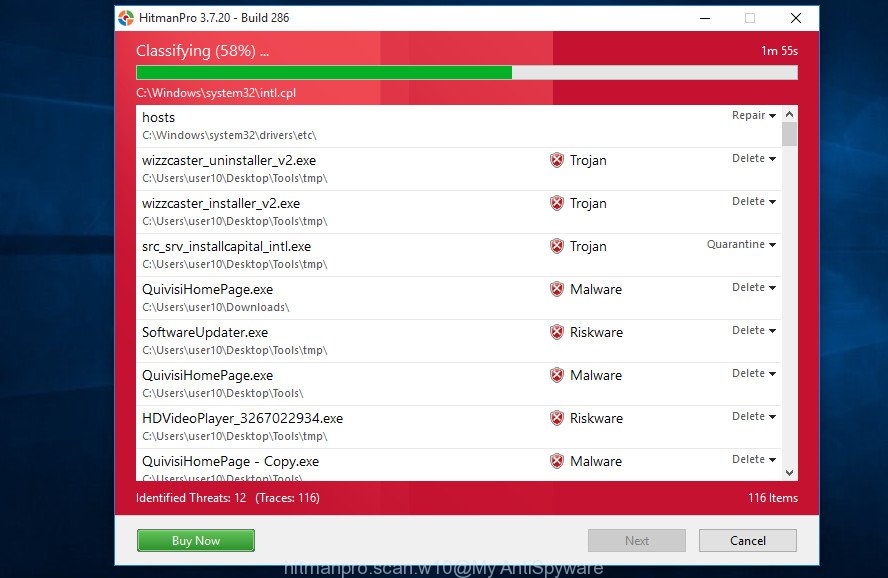
After the checking is done, it will show the Scan Results.
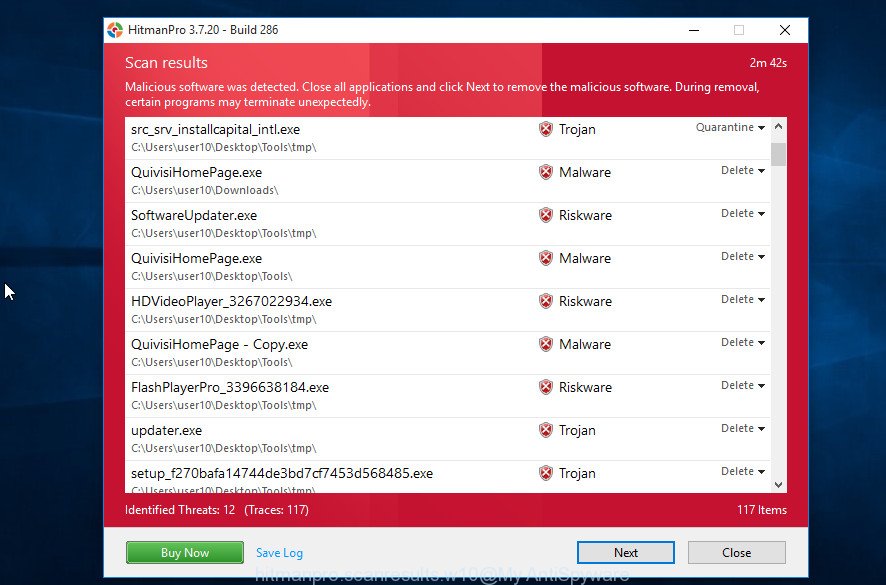
Make sure all threats have ‘checkmark’ and click Next button.
It will display a prompt, click the “Activate free license” button to begin the free 30 days trial to remove all malware found.
Delete Shortcuts with MalwareBytes AntiMalware (MBAM)
We recommend using the MalwareBytes Free which are completely clean your computer of the adware software. The free tool is an advanced malware removal program developed by (c) Malwarebytes lab. This application uses the world’s most popular antimalware technology. It’s able to help you remove Shortcuts from your web-browsers, potentially unwanted software, malware, hijackers, toolbars, ransomware and other security threats from your computer for free.
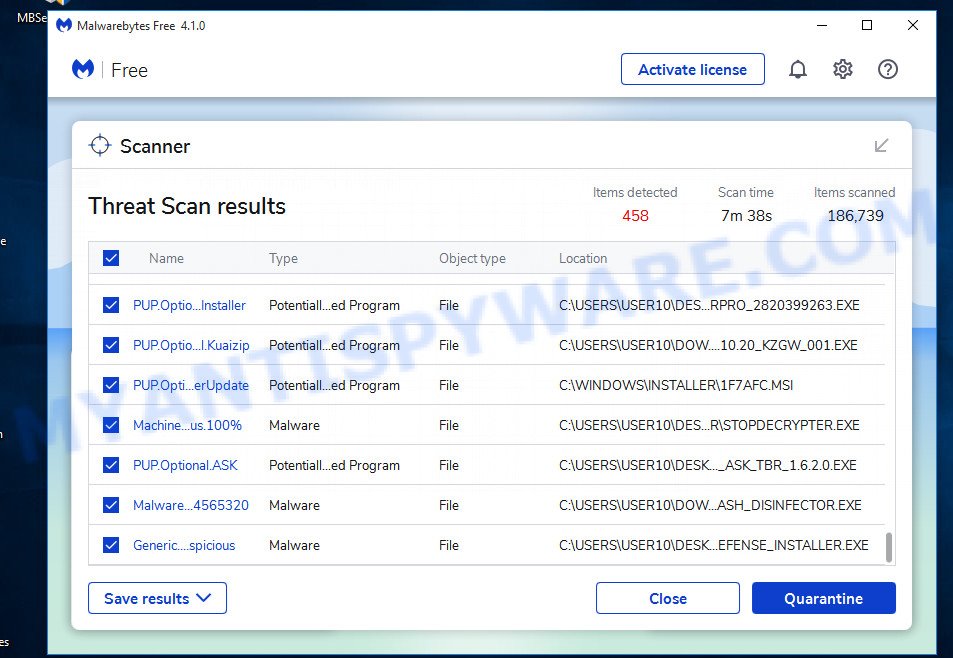
Download MalwareBytes Anti Malware by clicking on the following link.
327071 downloads
Author: Malwarebytes
Category: Security tools
Update: April 15, 2020
Once the downloading process is complete, run it and follow the prompts. Once installed, the MalwareBytes Anti Malware will try to update itself and when this procedure is done, press the “Scan” button to perform a system scan for the Shortcuts adware. A scan may take anywhere from 10 to 30 minutes, depending on the number of files on your computer and the speed of your computer. When a malicious software, adware or PUPs are detected, the count of the security threats will change accordingly. Wait until the the checking is complete. You may delete threats (move to Quarantine) by simply press “Quarantine” button.
The MalwareBytes Anti Malware (MBAM) is a free program that you can use to delete all detected folders, files, services, registry entries and so on. To learn more about this malware removal utility, we suggest you to read and follow the few simple steps or the video guide below.
How to stay safe online
It’s important to run ad blocker applications such as AdGuard to protect your PC system from harmful web-sites. Most security experts says that it is okay to block advertisements. You should do so just to stay safe! And, of course, the AdGuard can to stop misleading and other unwanted webpages.
- Installing the AdGuard is simple. First you’ll need to download AdGuard by clicking on the link below. Save it to your Desktop.
Adguard download
26843 downloads
Version: 6.4
Author: © Adguard
Category: Security tools
Update: November 15, 2018
- Once downloading is complete, start the downloaded file. You will see the “Setup Wizard” program window. Follow the prompts.
- When the setup is done, click “Skip” to close the install application and use the default settings, or click “Get Started” to see an quick tutorial which will help you get to know AdGuard better.
- In most cases, the default settings are enough and you do not need to change anything. Each time, when you launch your personal computer, AdGuard will launch automatically and stop undesired advertisements, block Shortcuts redirects, as well as other harmful or misleading webpages. For an overview of all the features of the program, or to change its settings you can simply double-click on the icon called AdGuard, which is located on your desktop.
Finish words
We suggest that you keep Zemana (to periodically scan your computer for new adware softwares and other malicious software) and AdGuard (to help you block unwanted ads and malicious web pages). Moreover, to prevent any adware, please stay clear of unknown and third party apps, make sure that your antivirus program, turn on the option to detect PUPs.
If you need more help with Shortcuts related issues, go to here.


















